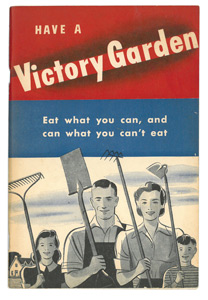5/29/2014
V is for Victory
Jennifer Polanz
 “Victory Garden program for 1945 will assume major importance. Need all food we can grow in home gardens to back up war. Want everyone who had garden last year to continue. This will create need for millions of vegetable plants. Your industry helpful in past. We hope it will continue next year.”
“Victory Garden program for 1945 will assume major importance. Need all food we can grow in home gardens to back up war. Want everyone who had garden last year to continue. This will create need for millions of vegetable plants. Your industry helpful in past. We hope it will continue next year.”
—A telegram from E. G. Moore, Director of Information of the War Food Administration to the Society of American Florists, published in the February 1945 issue of GrowerTalks
We may not have the urgency of the war effort behind our gardens, but with continued food safety concerns and rising prices at the grocery stores, Americans are quickly complementing their shopping trips with journeys to their back yard (and patio) gardens. And our industry has been there to supply the vegetable seeds and starts to keep Americans growing (literally). We thought it would be a fascinating trip through time to look at a classic Victory Garden to see just how much has changed (and how much has stayed the same).
Based on a look back in World War II-era
GrowerTalks issues, we found the following list of plant suggestions:
- Leaf lettuce
- Tomatoes (Master Marglobe and Earliana were mentioned specifically)
- Sweet peppers (specifically California Wonder and Oakview Wonder)
- Eggplants
- Cabbage (specifically Golden Acre for early and Late Flat Dutch for late)
- Cauliflower (Early Erfurt and Early Snowball)
- Celery (Epicure, Golden Plume, Golden Yellow Self-Blanching Dwarf)
- Beets
- Kohlrabi
- Cucumbers
- Melons
And some fascinating facts from the National World War II Museum for those who aren’t familiar with the history of the Victory Garden (I know some of these surprised me!):
- The planting efforts at home started during World War I and was called a War Garden. Once the war was over, they became known as Victory Gardens.
- At their peak during World War II, there were more than 20 million Victory Gardens across the United States.
- They were necessary to prevent food shortages and to help rationing coupons for canned vegetables stretch farther.
- Many schools around the country planted Victory Gardens on their school grounds and used their produce in their school lunches.
- By 1944, Victory Gardens were responsible for producing 40% of all vegetables grown in the United States. More than 1 million tons of vegetables were grown in Victory Gardens during the war.
GP